As we begin modeling 3d model in this new fashion through SketchUp, I feel that it brings me a positively unique experience.
Compared to traditional 3d modeling in SketchUp, this method of creation is greatly disparate, the most significant of which is that it is more accurate, in terms of real-life coordination, and simpler. Just as you 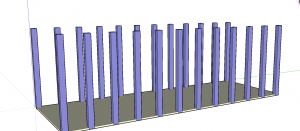 can see in this figure, in which I attempted at first to model Myers Hall in the traditional method, there is no indication of any sorts of numerical placements, coordination and measurement;, which immensely degrades precision and reliability; in fact, the most elementary information, the length, width and height of the building, is even greatly different and inaccurate compared to the newly designed model. Moreover, figuring out the essential data logically (how wide is each pillar? how obtruded is each window?) is way more time-consuming and laborious to apply than orienting the coordinate correctly and drawing lines on an existing photo of the building.
can see in this figure, in which I attempted at first to model Myers Hall in the traditional method, there is no indication of any sorts of numerical placements, coordination and measurement;, which immensely degrades precision and reliability; in fact, the most elementary information, the length, width and height of the building, is even greatly different and inaccurate compared to the newly designed model. Moreover, figuring out the essential data logically (how wide is each pillar? how obtruded is each window?) is way more time-consuming and laborious to apply than orienting the coordinate correctly and drawing lines on an existing photo of the building.
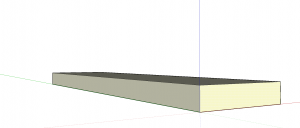
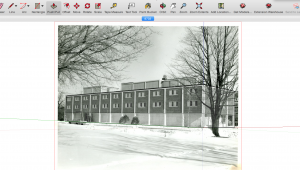 Of course, much frustration was engendered during the process. Particularly, many times when I evenly copy and pace certain objects, such as a rectangle for a pillar, they would constantly be placed at the wrong location,
Of course, much frustration was engendered during the process. Particularly, many times when I evenly copy and pace certain objects, such as a rectangle for a pillar, they would constantly be placed at the wrong location, 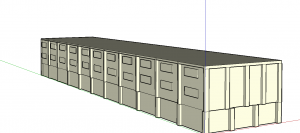 deviating bit by bit for every single one of them, which forces me to sometimes manually drag them back or redo the entire process. Moreover, it was difficult for me to trace the details in absolute precision; for instance, one of the edge of the building is not aligned properly with the photos potentially due to the initial imprecise alignment of the coordinates for the photo. This can definitely present a challenge late in the future as it seems to be an inevitable man-made error. This compels certain summary and advice for me- be as precise as possible for each procedure
deviating bit by bit for every single one of them, which forces me to sometimes manually drag them back or redo the entire process. Moreover, it was difficult for me to trace the details in absolute precision; for instance, one of the edge of the building is not aligned properly with the photos potentially due to the initial imprecise alignment of the coordinates for the photo. This can definitely present a challenge late in the future as it seems to be an inevitable man-made error. This compels certain summary and advice for me- be as precise as possible for each procedure 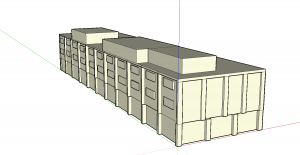 so that the following step will not end up catastrophically and will not force you to compensate for the mistake poorly or retrace painstakingly back to the original issue.
so that the following step will not end up catastrophically and will not force you to compensate for the mistake poorly or retrace painstakingly back to the original issue.
Regardless, the fact that I was able to complete this basic 3D model (adequately?) still feels victorious for me. It is the result of pain, devotion and concentration and it definitely have contributed to my own sense of scholarship.
Wilson,
Your hard work and frustration paid off! It is looking really good. You are never going to get 100 percent accuracy working from just a few historic photos, but you have made a really strong start. To go further, project the photos and start modeling additional details and then add final textures to make it look as realistic as possible.
Wilson,
Your model looks fantastic! I absolutely agree that this method is a lot more precise. But I’m curious, did you find this form of modeling easier than the free form modeling? Also, in what way did this contribute to your scholarship?
I had a very similar struggle with tracing my buildings to absolute precision. One miss click could throw your entire building off, which is why tracing could be really frustrating at times. I found that zooming in, though time consuming, was really helpful in making precise traces. Anyways, I really like how you include multiple photos showing your step by step progress in the construction of your building. Despite the struggles that you dealt with, your product looks good!
Boxy buildings like Myers look simple at first, but as you show it’s really the amount of details and the need for precision where things get really complicated! This isn’t something I thought much about in free-form drawing my own house, but now that it’s becoming very relevant I appreciate your insight and tips.
Plus, it’s so interesting to see Myers when it only had three floors! I’ve always been curious about how/why the fourth floor was built, and what those shapes on top of the original building were for. Your model is going to be a good way for people like me to understand how the campus has changed over time.